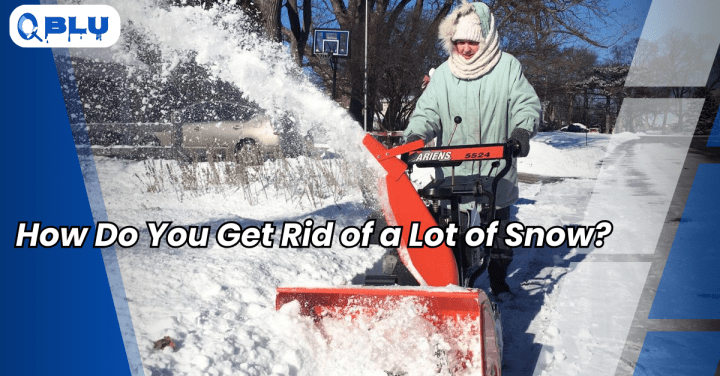Ah, winter in London, Ontario – when our charming city is blanketed in a sparkling coat of snow. Beautiful? Absolutely. But let’s be real: all that snow can be a bit of a hassle, right?
Whether you’re trying to get out the door for work, keep your business running smoothly, or avoid turning your driveway into a mini ski slope, dealing with heavy snowfall is a big part of our winter routine.This brings us to a crucial question many of us face: How do you get rid of a lot of snow?
That’s where we come in. We’re diving into snow removal, from shovels to handy tricks. Have you ever considered using beet juice to melt ice or wondered about the pros and cons of professional snow removal?
So, grab some hot cocoa and stay tuned. Whether you’re a seasoned snow warrior or seeking winter tips, we’ve got cool insights!
Want to Get Rid of a Lot of Snow? 6 Common Challenges
Here are the common obstacles that arise when facing a significant snowfall –
- Sheer Volume
A heavy snowfall can bury driveways, walkways, and roads under thick layers of snow, making it a daunting task to clear everything.
- Icy Layers
Snow can melt and refreeze, forming icy patches that are difficult to remove and treacherous to walk on.
- Limited Time
Snow doesn’t wait; clearing a large amount of snow can be challenging when you have other commitments like work or school.
- Physical Strain
Manual snow removal techniques like shoveling can be physically demanding and even lead to injuries if not done correctly.
- Equipment Limitations
Not all equipment is suitable for handling large amounts of snow effectively. Some may struggle with heavy or wet snow.
- Environmental Concerns
Certain ice melters and snow removal methods can have environmental implications, such as damage to vegetation and groundwater contamination.
Manual Snow Removal Methods
1. Shoveling
- Choosing the Right Shovel
When it comes to shoveling, a key part of answering the question “how do you get rid of a lot of snow?” One size does not fit all. The right shovel depends on factors like the snow you’re dealing with, your physical strength, and the area you need to clear. Consider a scoop shovel with a curved blade for wet, heavy snow. An ergonomic snow pusher might be your best bet if you have a large area to clear. We’ll guide you in selecting the perfect shovel to make your job easier.
- Proper Shoveling Techniques
Shoveling snow can be physically demanding, but some techniques can minimize strain. Start by warming up your muscles, then push the snow whenever possible instead of lifting it. When lifting is necessary, use your legs, not your back, to reduce the risk of injury. We’ll provide step-by-step instructions to ensure you’re shoveling efficiently and safely.
- Safety Precautions
Safety should always come first. Snow removal can be strenuous, and protecting yourself from cold temperatures and potential accidents is essential. Dress warmly in layers, stay hydrated, and take breaks as needed. Additionally, we’ll provide essential safety tips to remember while shoveling, such as avoiding overexertion and recognizing signs of cold-related illnesses.
2. Snow Blowing
- Types of Snow Blowers
Snow blowers come in various types, including single-stage, two-stage, and three-stage models. We’ll explore the differences and help you choose the right one for your needs. Single-stage blowers are great for lighter snowfalls, while two-stage and three-stage models are more suitable for heavy, deep snow.
- Operating a Snow Blower Effectively
To make the most of your snow blower, it’s crucial to understand how it works. We’ll share tips on starting and operating your snow blower efficiently. This includes techniques for maneuvering through different snow conditions and clearing large areas quickly.
- Snow Blower Maintenance Tips
Proper maintenance ensures your snow blower is always ready to tackle winter’s worst. We’ll cover maintenance practices, such as changing the oil, checking the spark plug, and inspecting the drill to keep your machine in top condition.
3. Ice Melting Solutions
- Traditional Ice Melts
Traditional ice-melting agents like salt, calcium chloride, and sand have unique properties and applications. We’ll delve into when and how to use them effectively. For example, salt prevents ice formation, while sand provides traction on slippery surfaces.
- Natural Ice Melts
If you’re environmentally conscious, we’ve got you covered. We’ll explore natural alternatives like beet juice, vinegar, and rubbing alcohol. These eco-friendly options can help you melt ice without harming the environment or landscaping.
Mechanical Snow Removal Methods
1. Hiring Professional Snow Removal Services
- Choosing a Snow Removal Company
If you’d instead leave the heavy lifting to the pros, consider factors like reputation and equipment when picking a snow removal company.
- Pros and Cons
Professional services offer convenience, but they come with costs and potential drawbacks. Weigh the pros and cons to make an informed choice.
2. Utilizing Snow Removal Equipment Rentals
- Types of Rental Equipment
Renting snow removal gear is an option. Learn about the available equipment, from snow blowers to plows, and which suits your needs.
- Costs and Availability
Budget wisely by understanding rental costs and equipment availability.
- Operating Safely
Using rented equipment requires safety know-how. Get tips on operating snow removal gear safely and efficiently.
Preventative Measures for Reducing Snow Accumulation
1. Installing Heated Driveways and Walkways
- Advantages and Disadvantages of Heated Driveways
Heated driveways and walkways can keep snow and ice at bay. Discover their benefits and considerations, including installation costs and efficiency.
- Installation Costs and Considerations
Get insights into the costs and factors to consider when installing heated systems.
- Maintenance and Operational Tips
Once installed, these systems need proper maintenance and operation. Learn how to keep them running smoothly.
2. Covering Surfaces with Tarps or Plastic Sheets
- Effective Placement of Tarps or Plastic Sheets
Covering surfaces with tarps or sheets can prevent snow accumulation. Find out where and how to place them effectively.
- Material Selection and Durability
Not all materials are suitable. Learn which ones work best and how to ensure durability.
- Removal and Storage Techniques
Removing and storing tarps or sheets correctly is essential when the snow has passed. We’ll guide these steps.
3. Utilizing Chemical Agents to Prevent Snow Bonding
- Application of Pre-emptive Snow Melting Solutions
Chemical agents can prevent snow from bonding to surfaces. Discover when and how to apply them effectively.
- Timing and Effectiveness of Chemical Agents
Timing is crucial. We’ll explain when to apply these solutions for the best results.
- Environmental Considerations and Safety Precautions
Using chemical agents requires safety precautions and awareness of environmental impact. We’ll cover these aspects.
Wrapping Up
Winter brings challenges, especially when you’re faced with the question, “how do you get rid of a lot of snow?” but snow removal can be manageable and safe with the right strategies. From manual methods to professional services like Qblu and preventative measures, you now have the tools to handle the snow season confidently.

